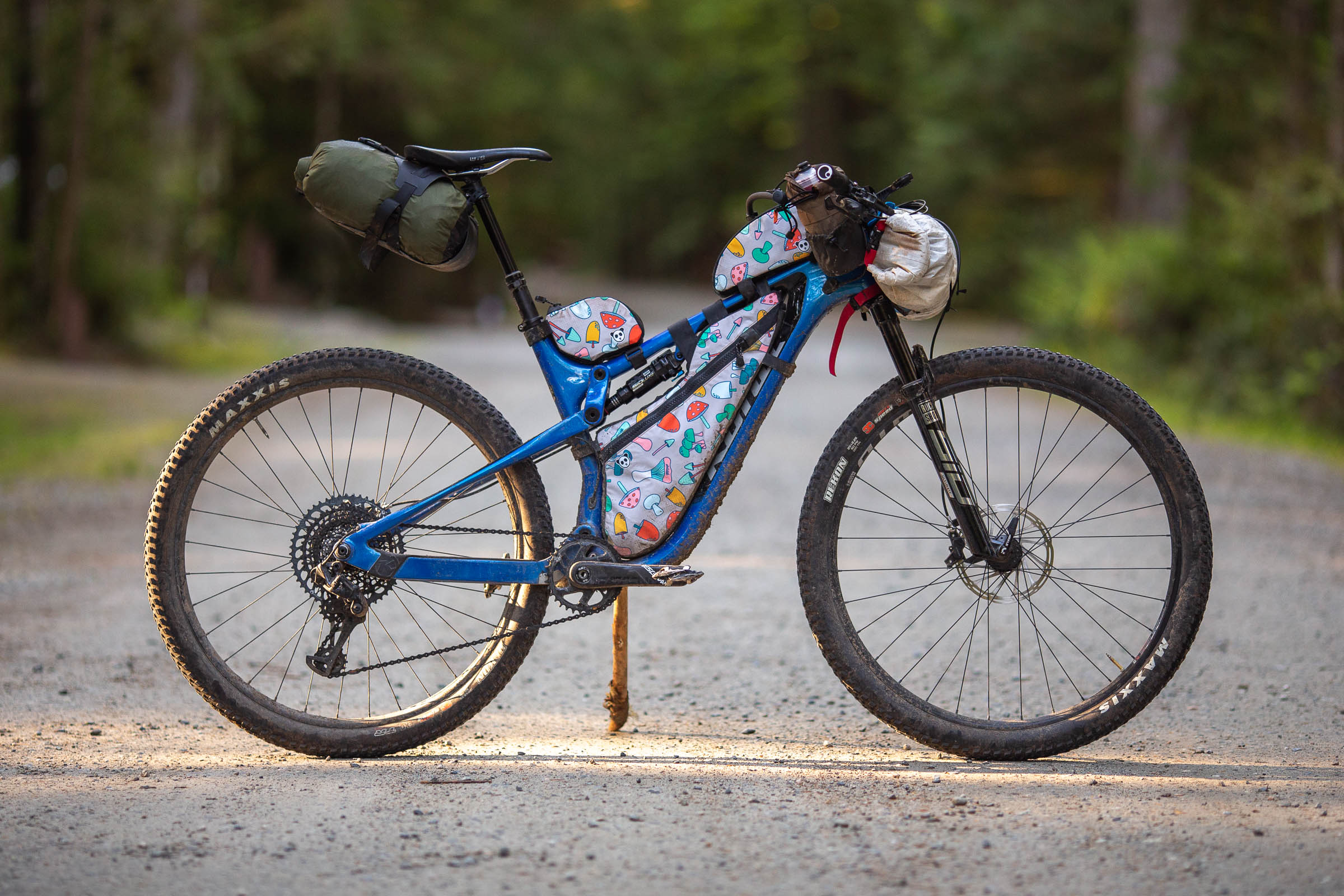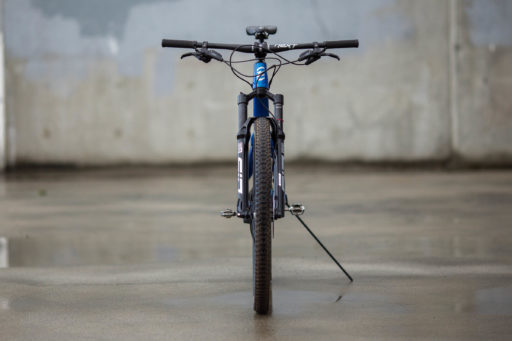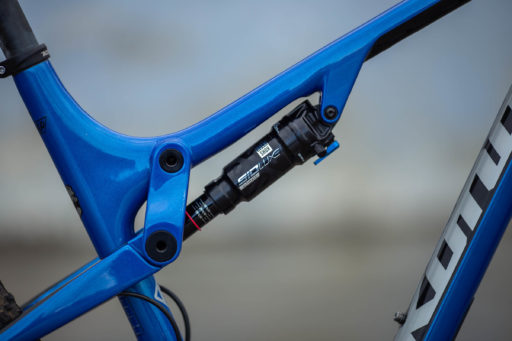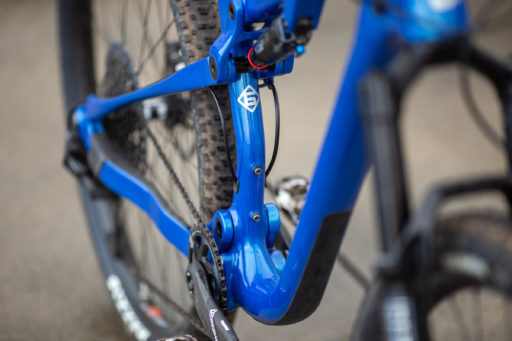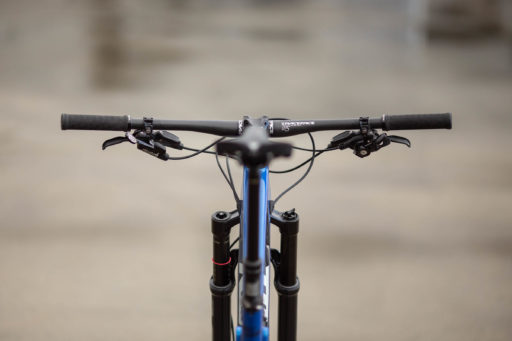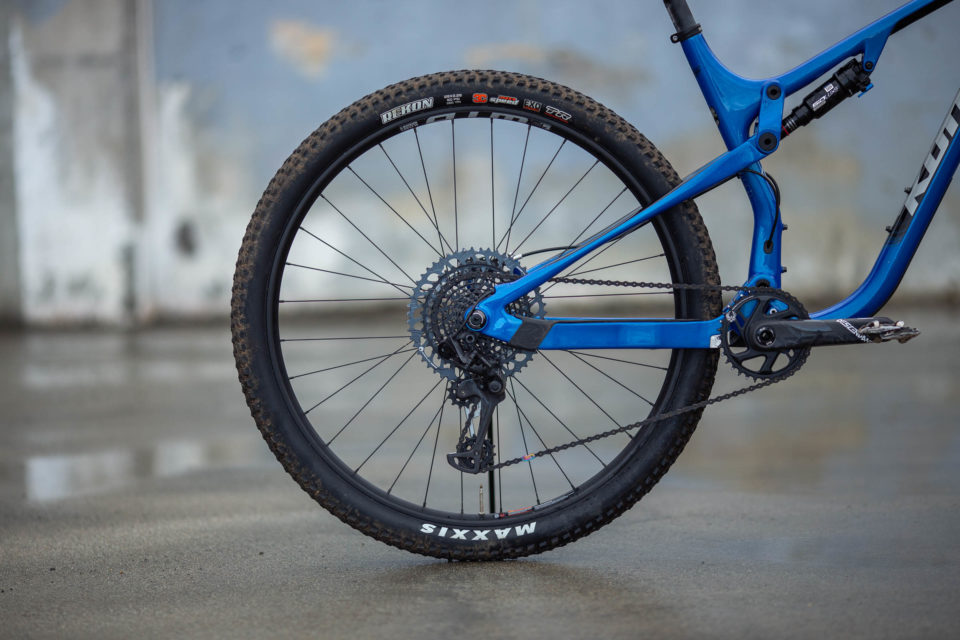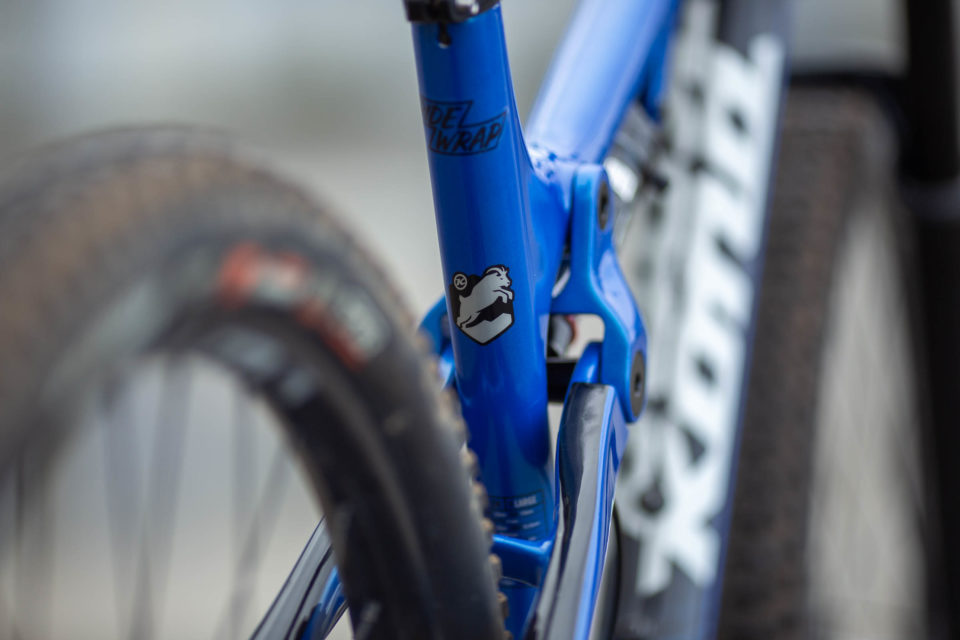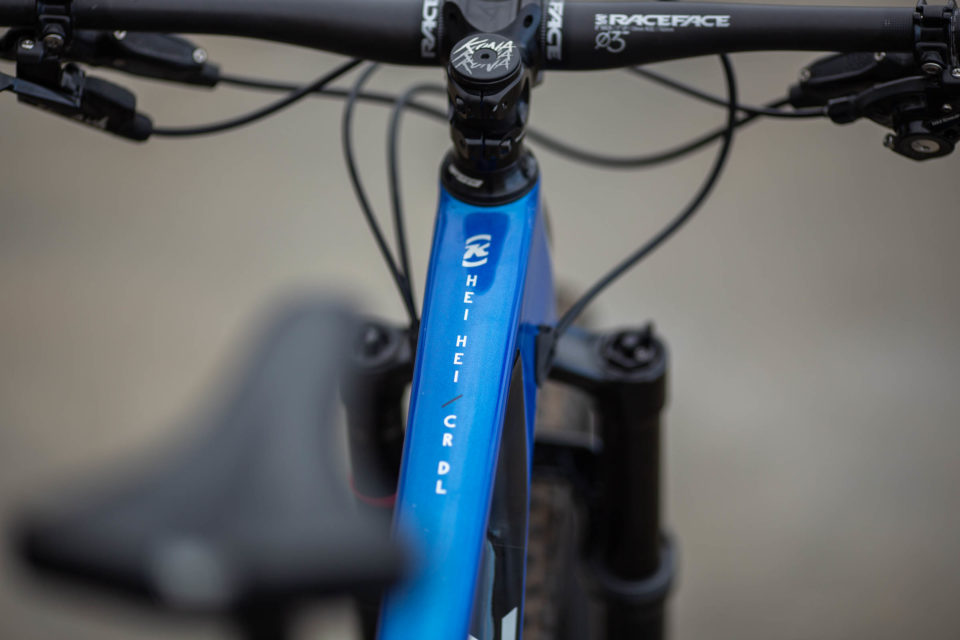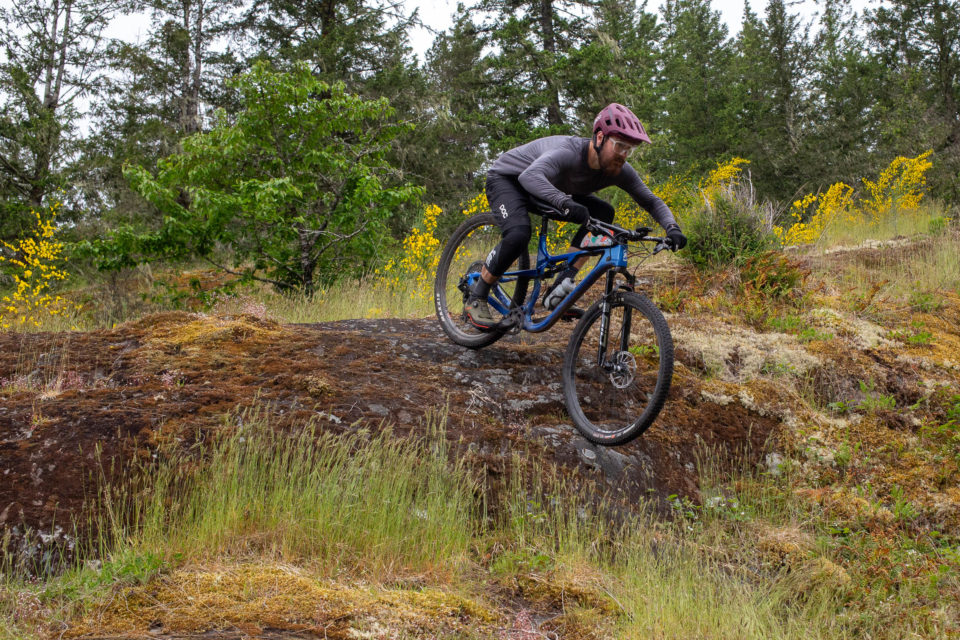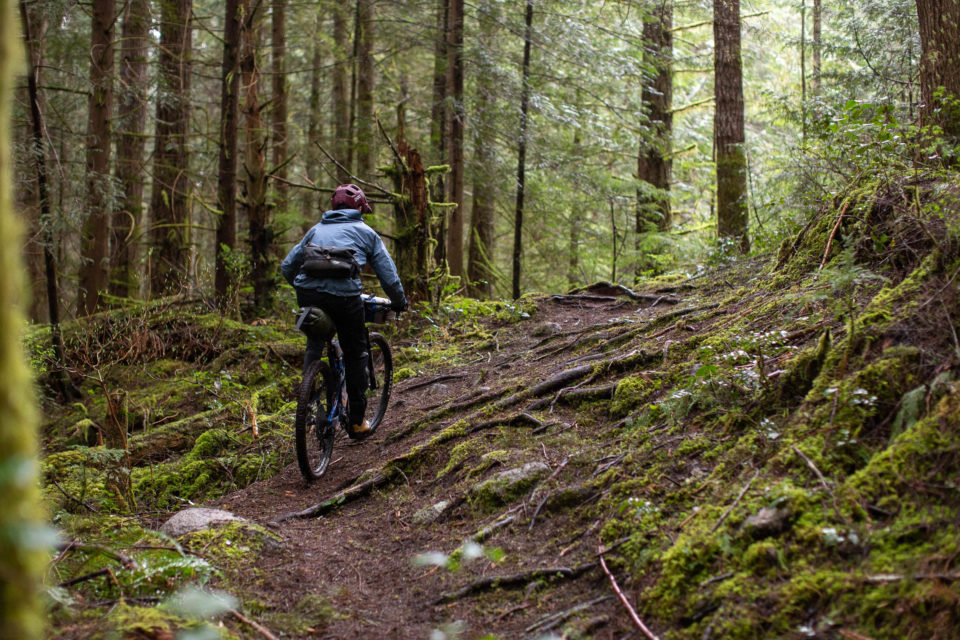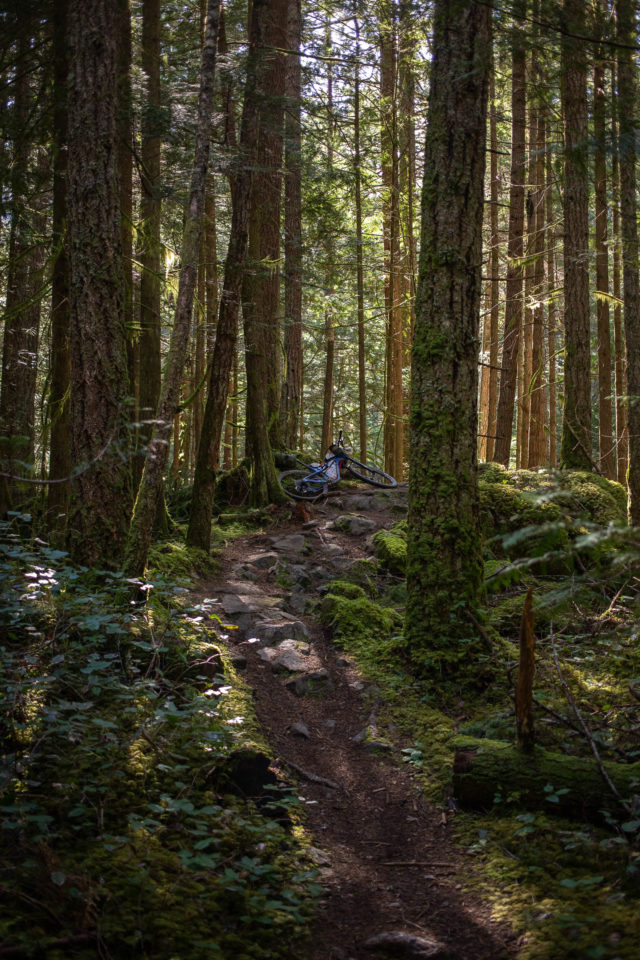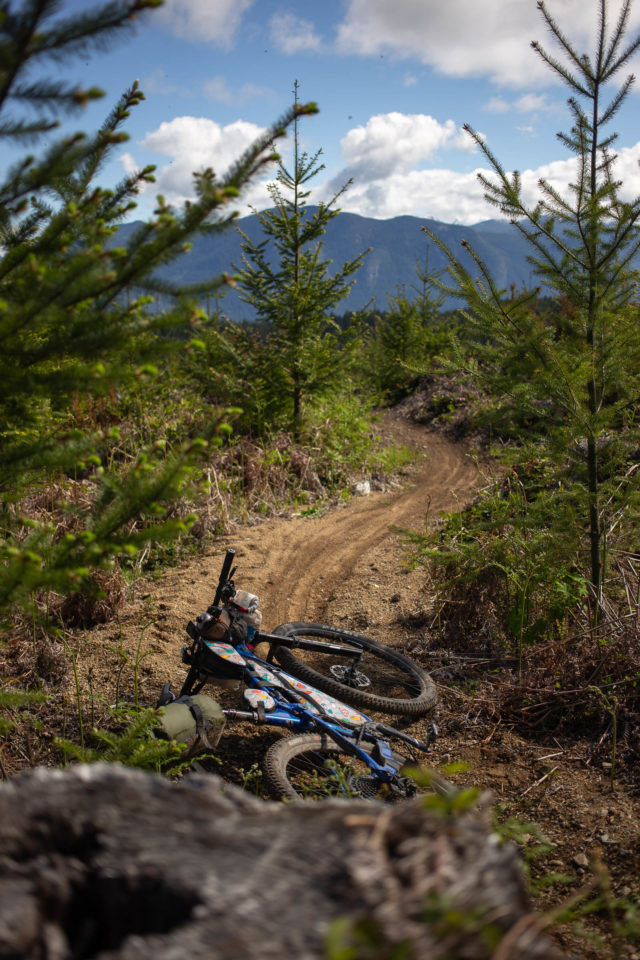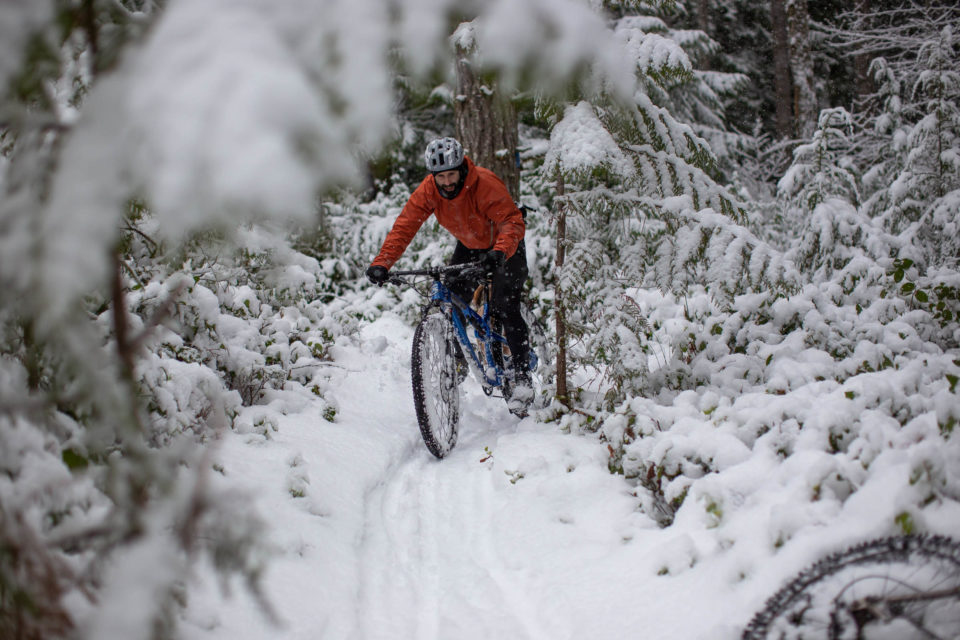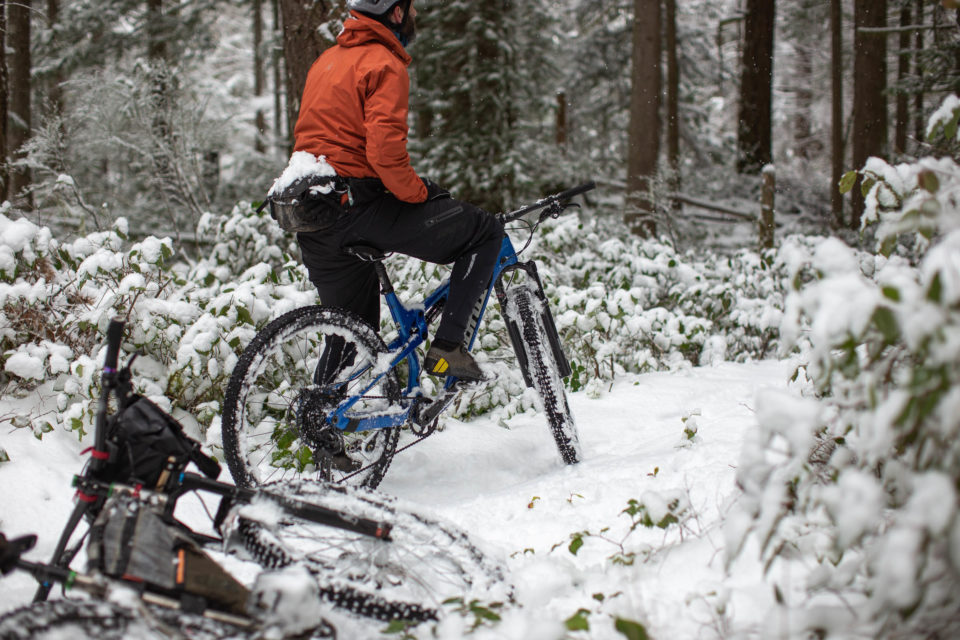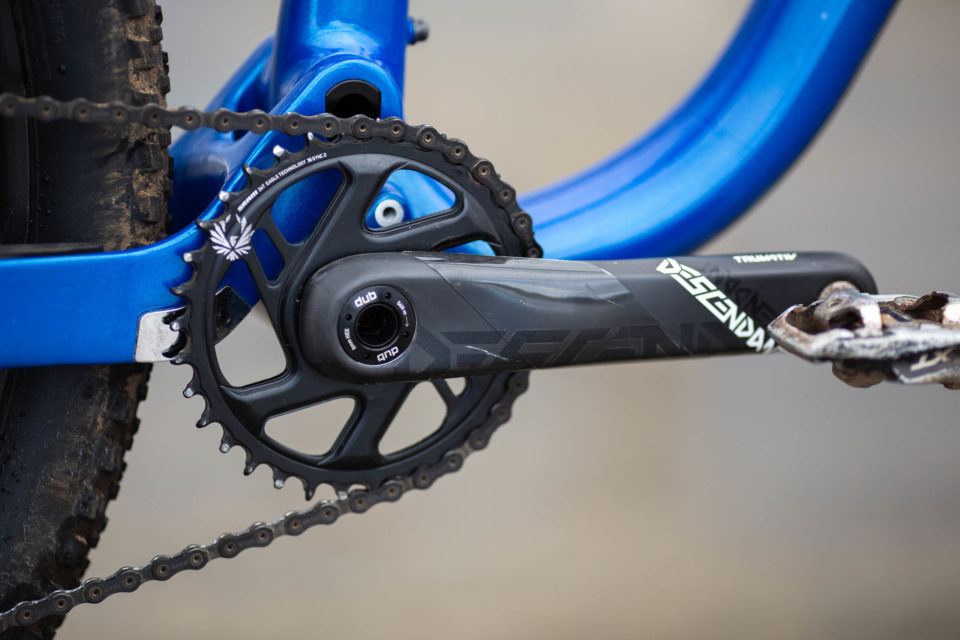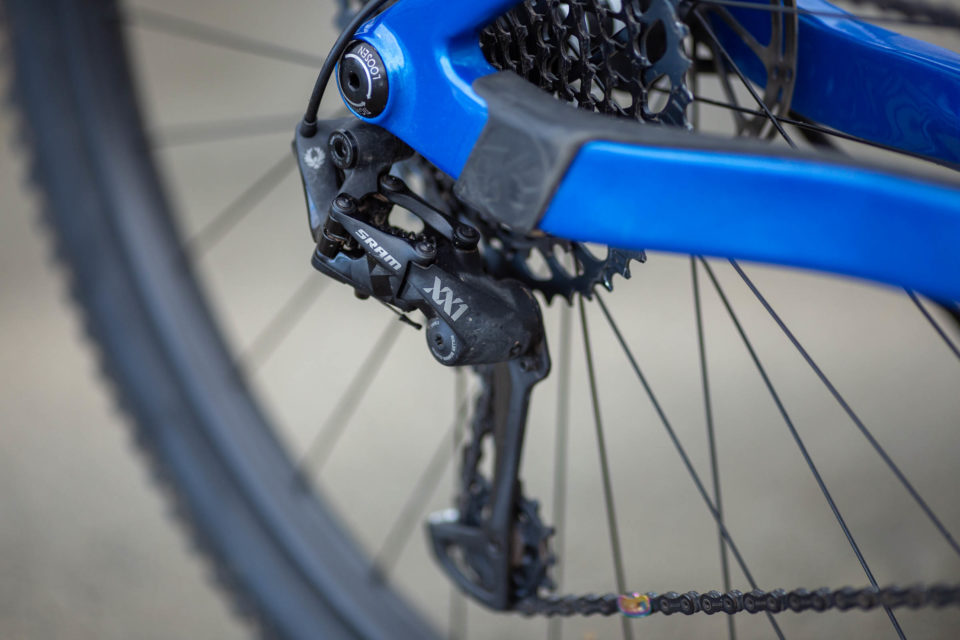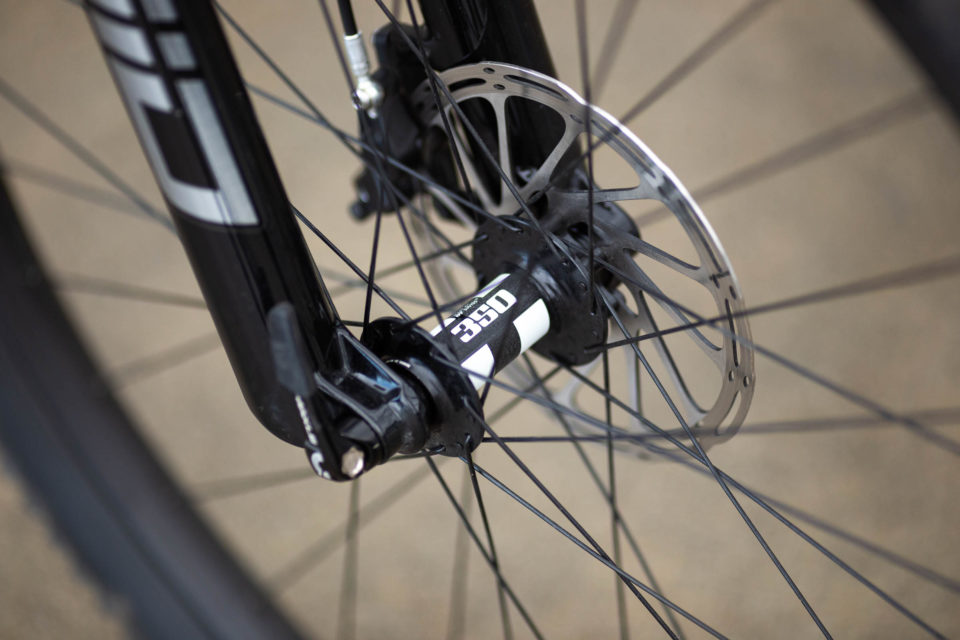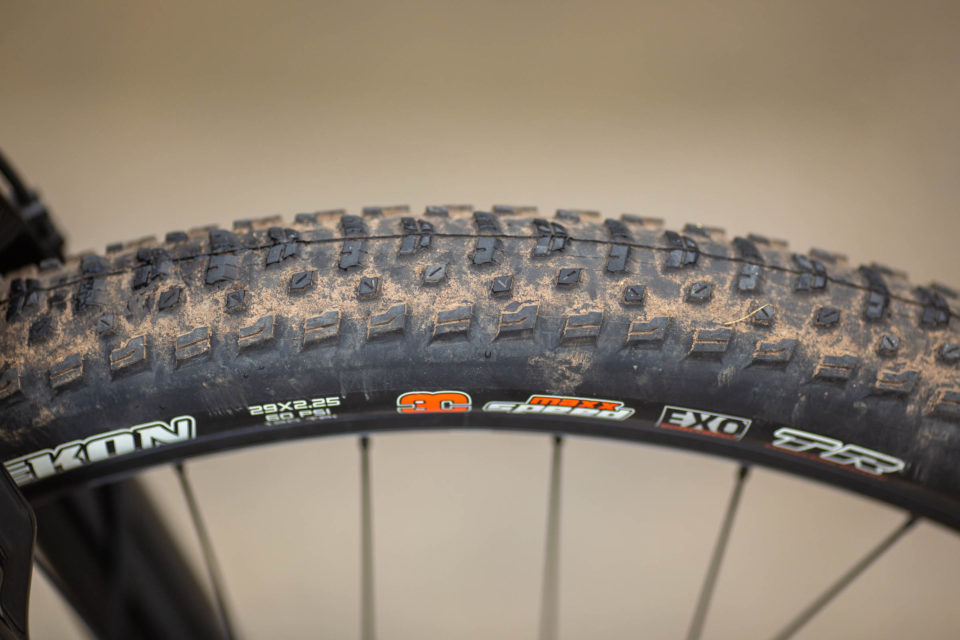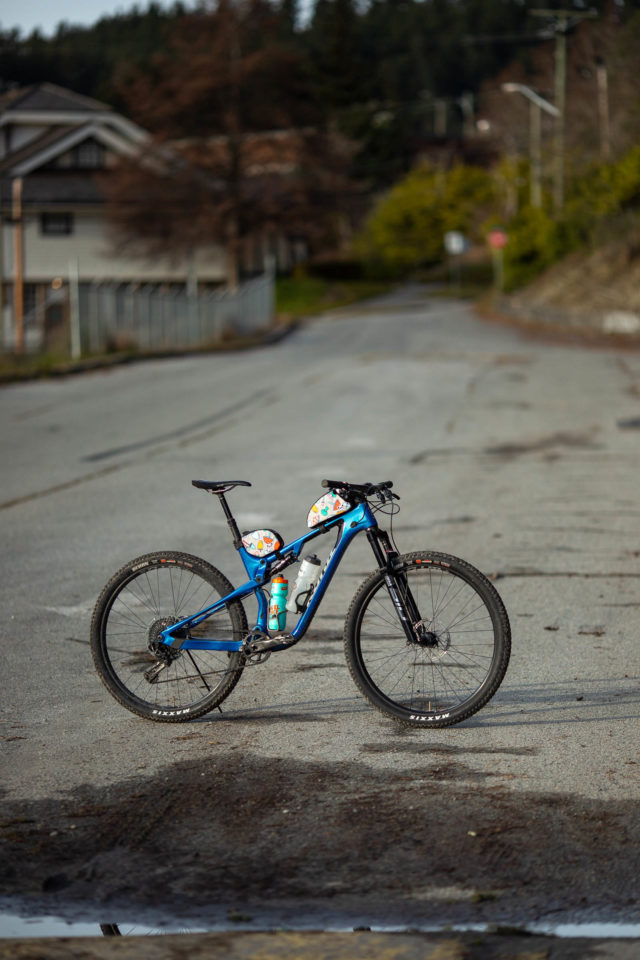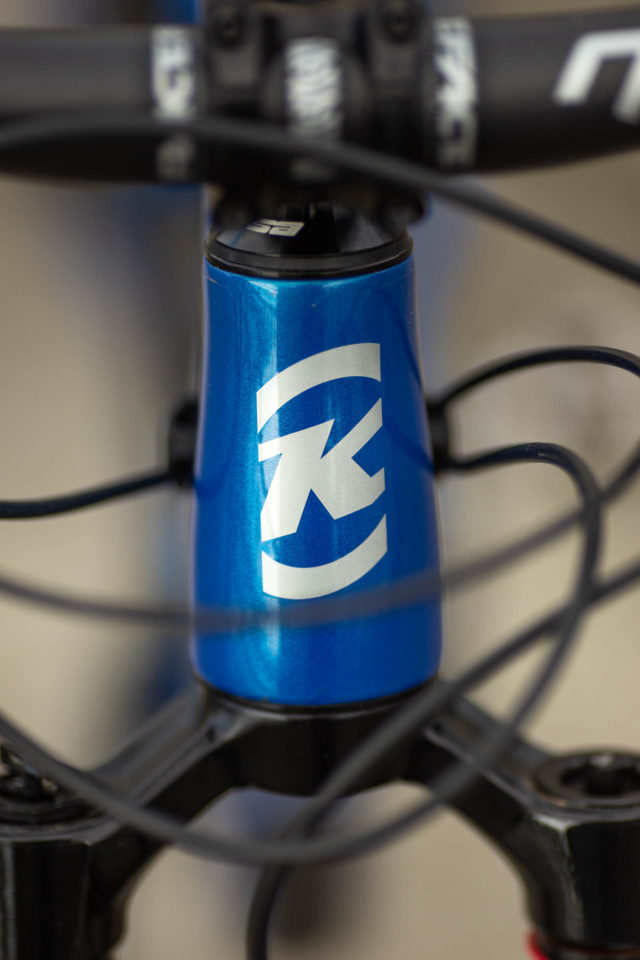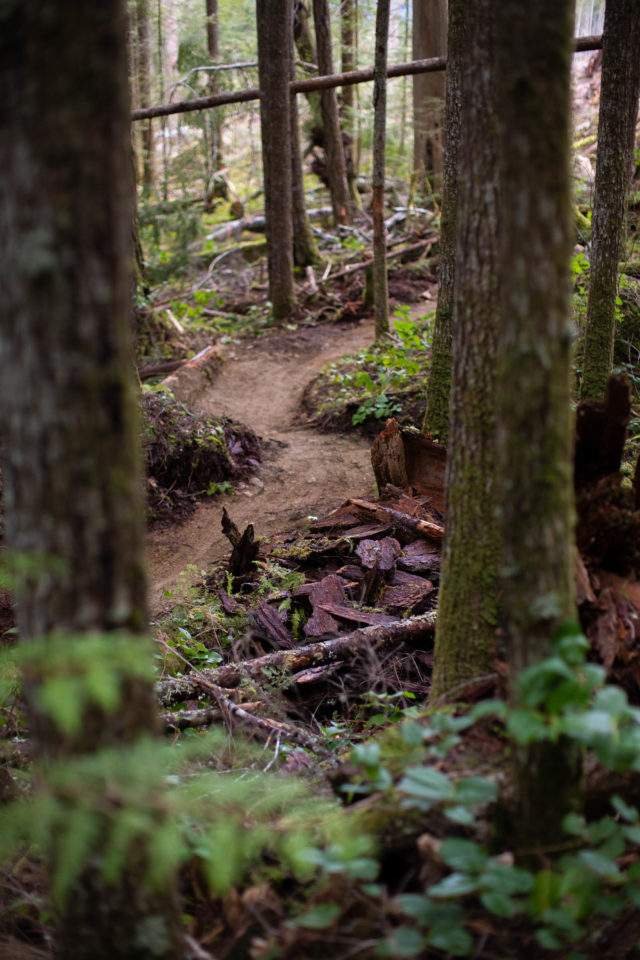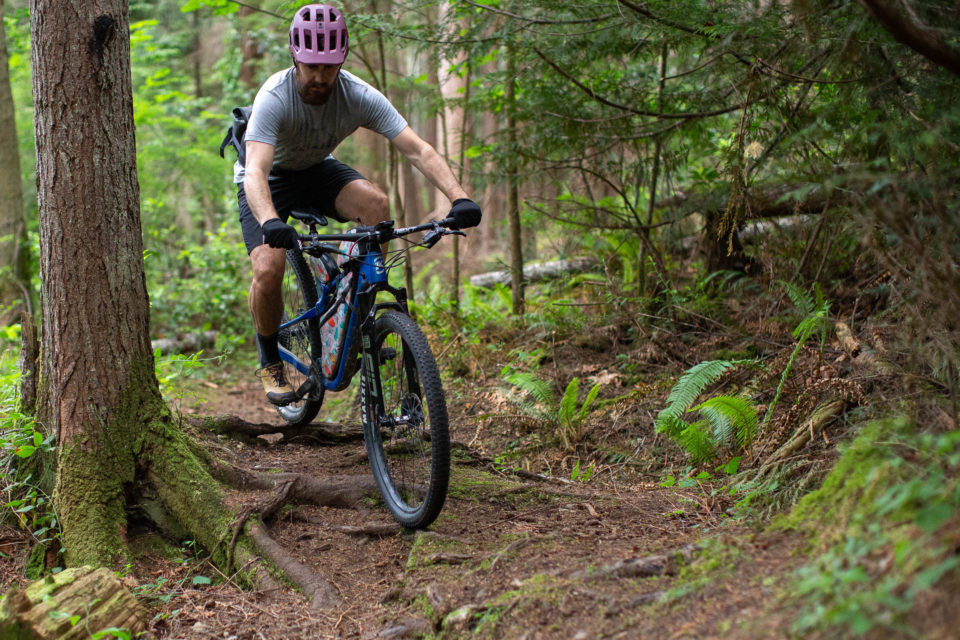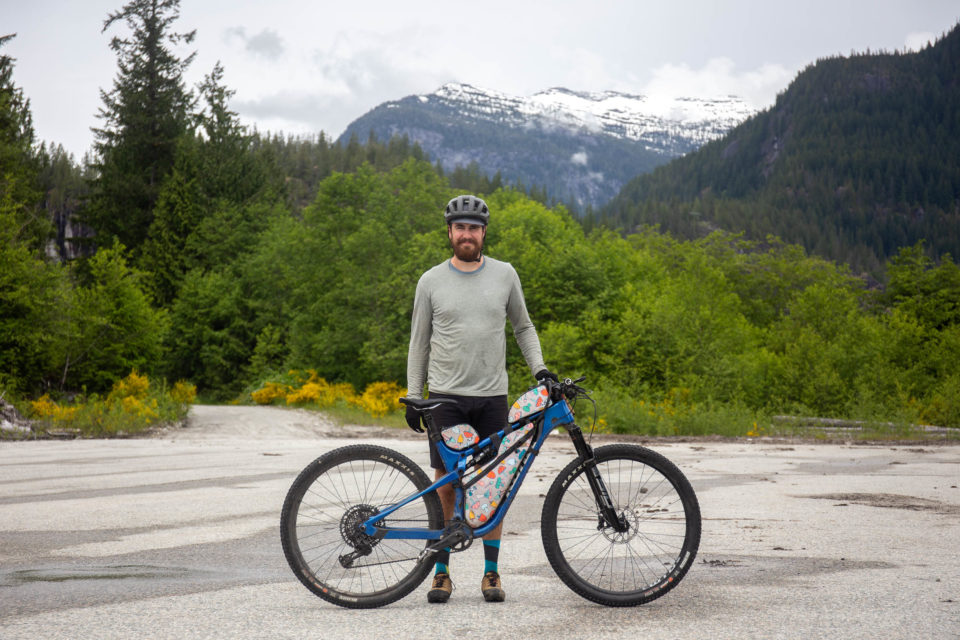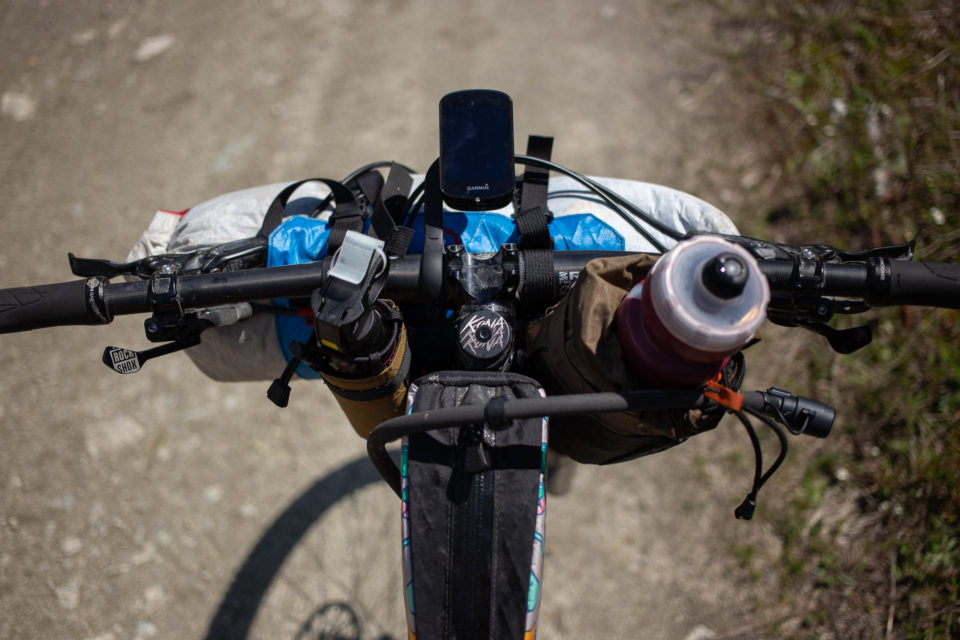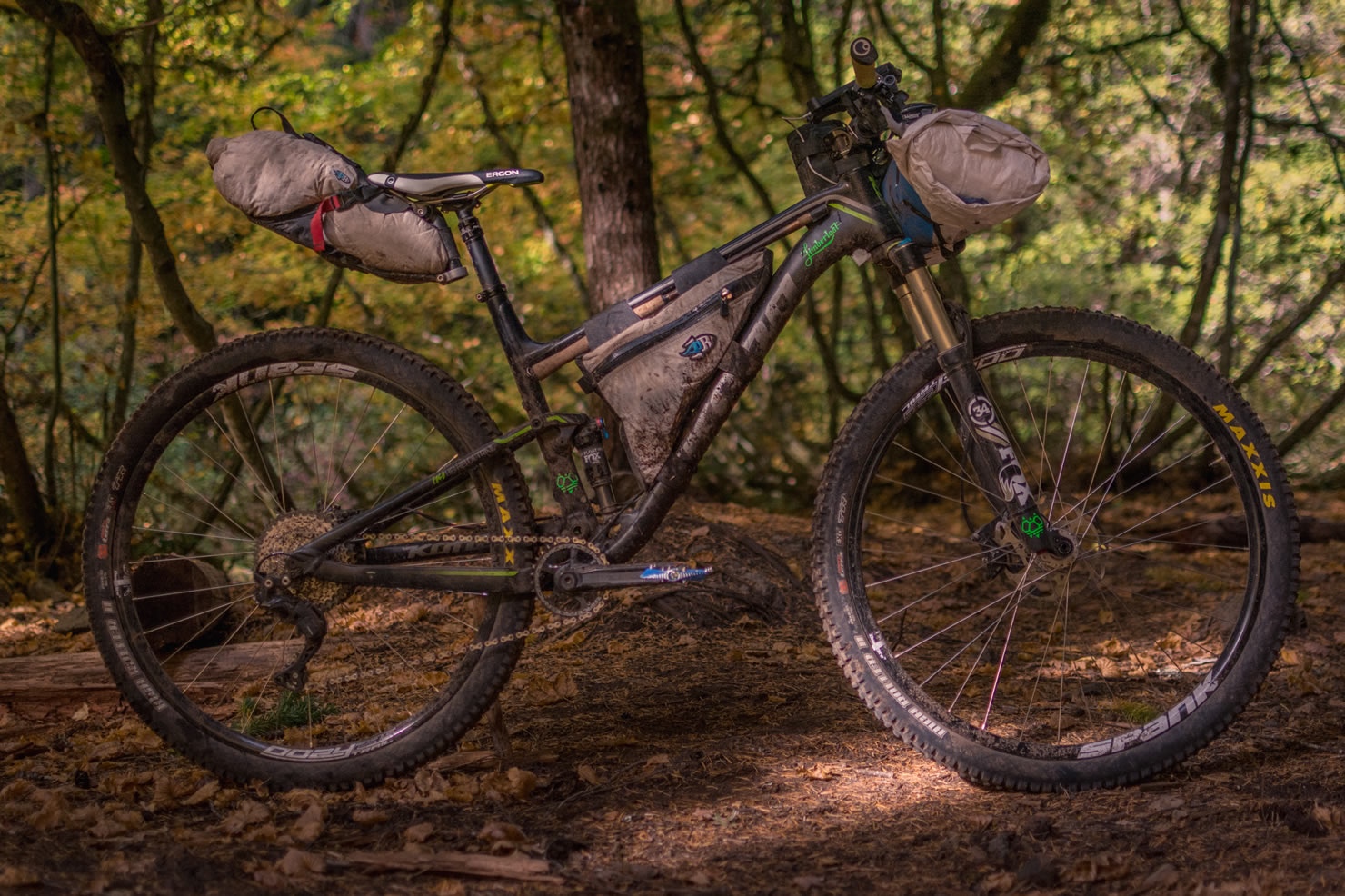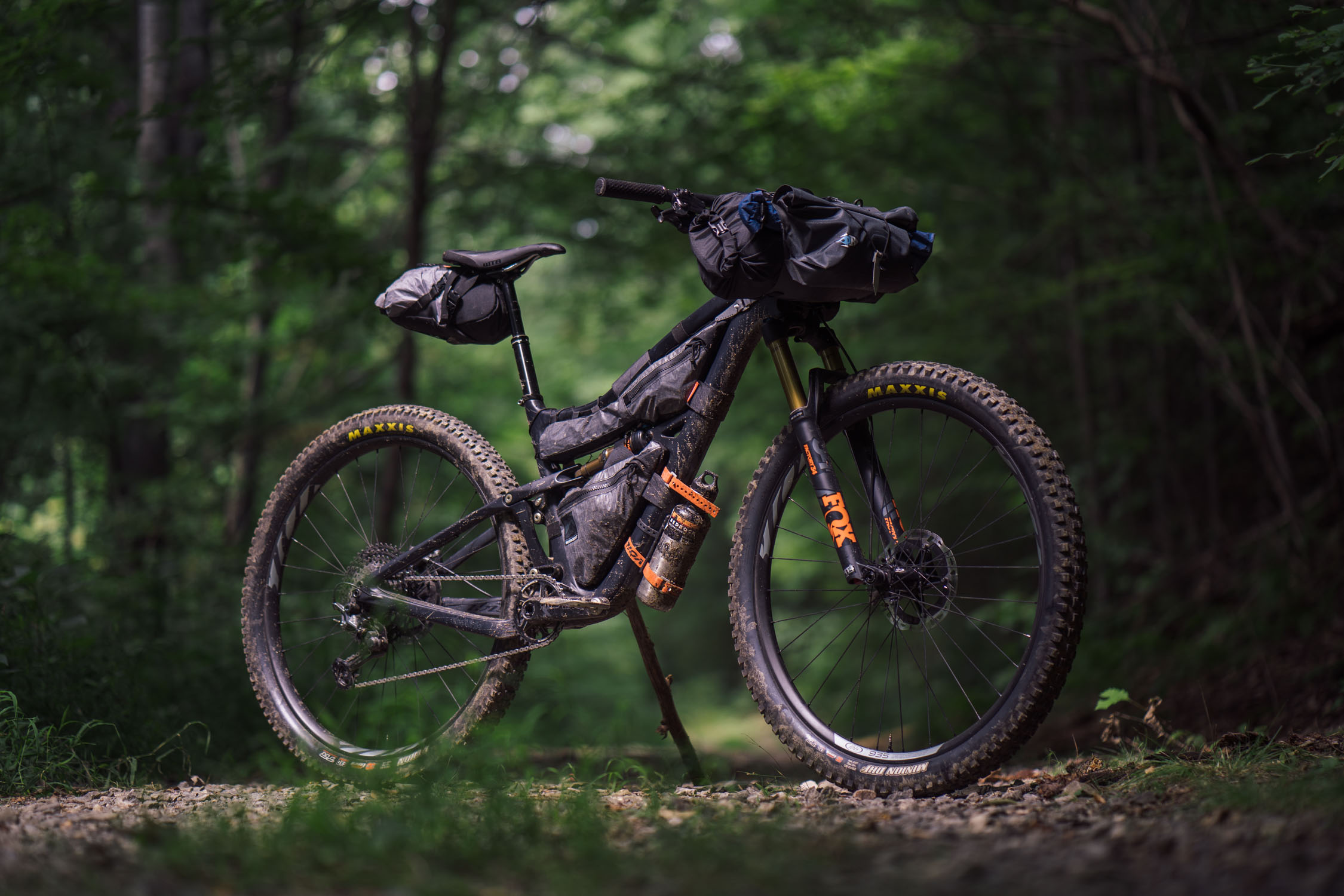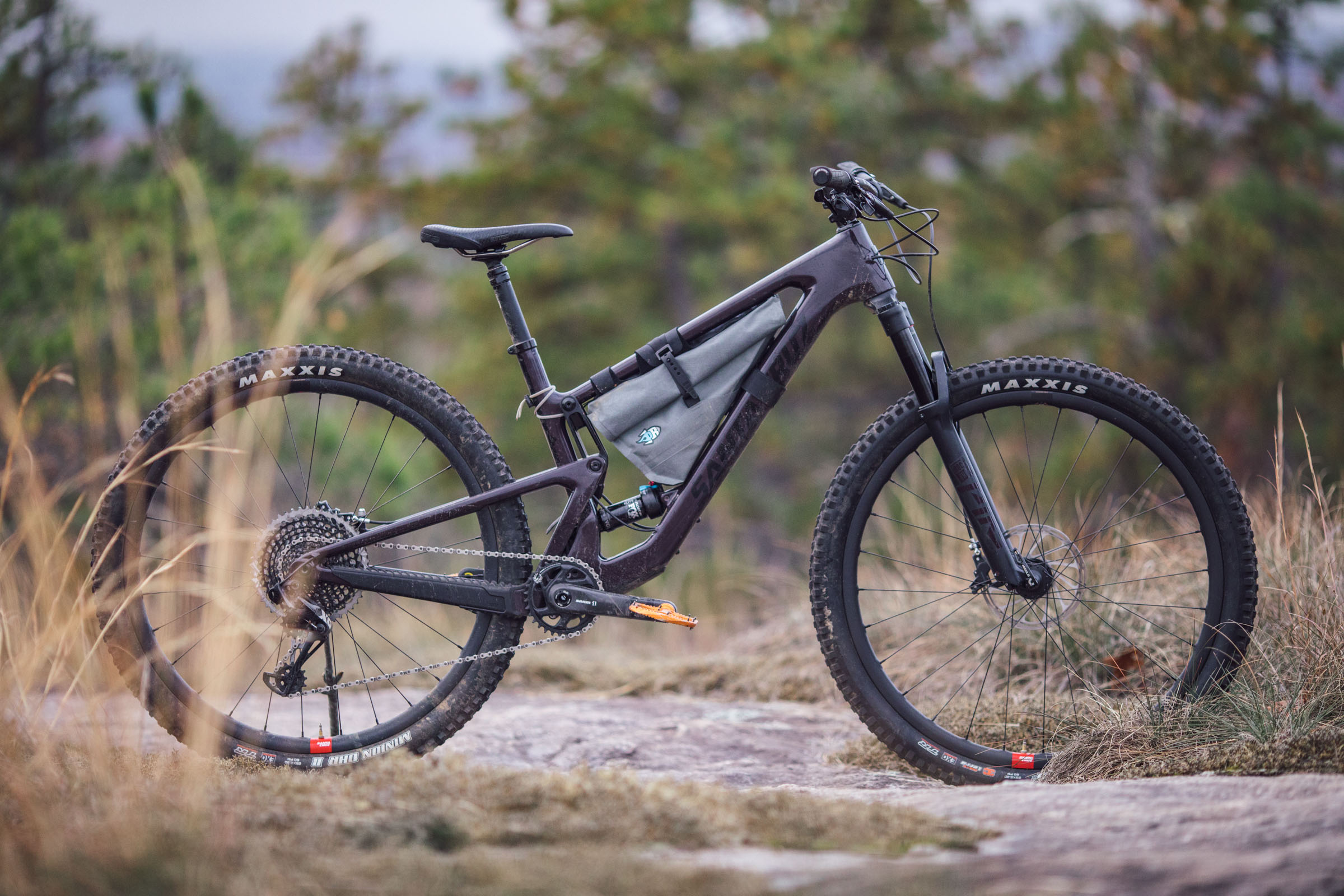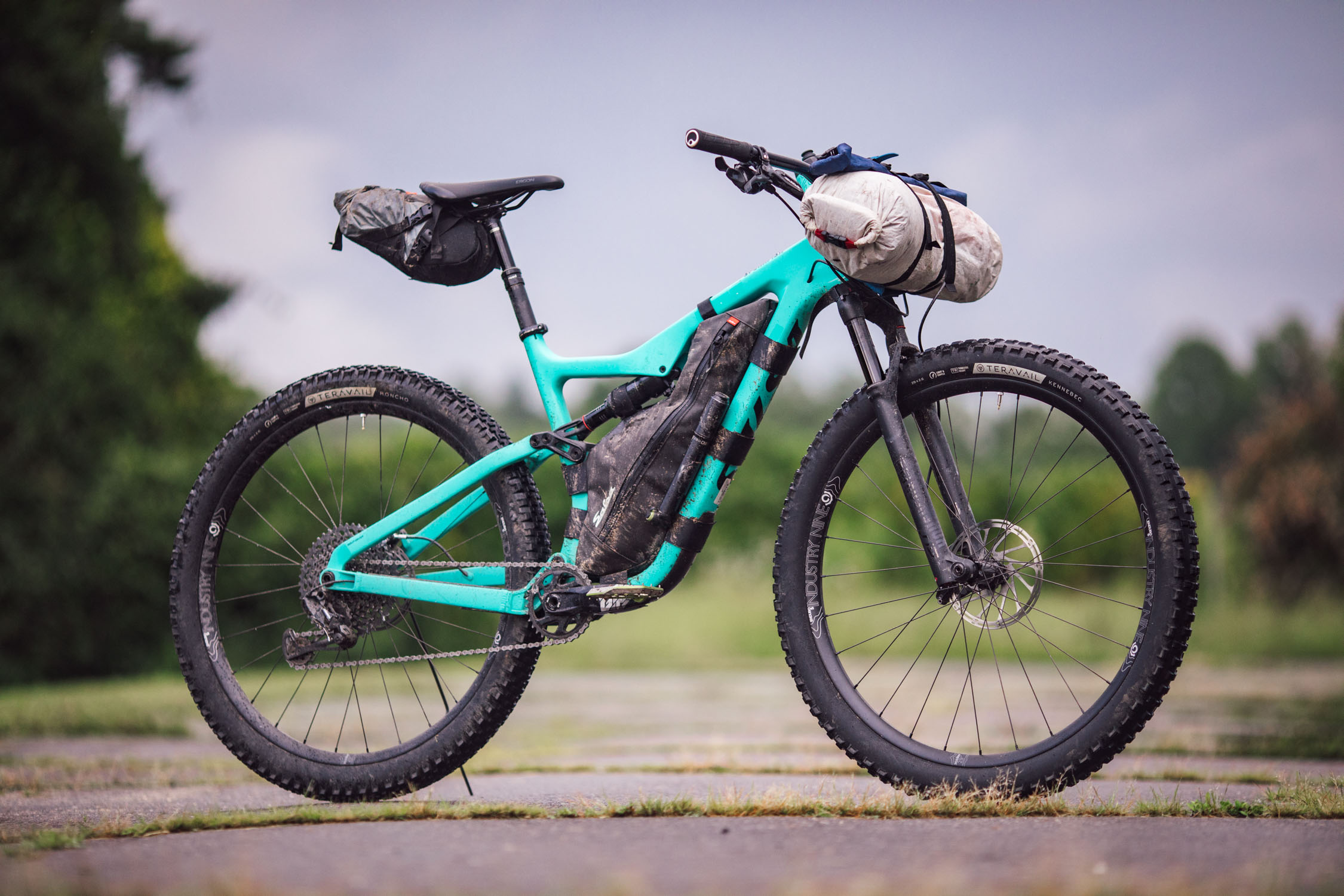Kona Hei Hei Review: Fastpacker Extraordinaire
The Kona Hei Hei is a short-travel full-suspension mountain bike on a mission to blur the lines between cross-country and trail bike. Its modern geometry and cavernous main triangle had us wondering how it would perform as a loaded bikepacking rig, and after four months of testing, we’re excited to share our findings. Find our detailed review of the Kona Hei Hei CR / DL here…
PUBLISHED Jun 3, 2021
The Kona Hei Hei has been in Kona’s lineup for nearly 20 years. From 1991 to 2000, it existed as a titanium hardtail with rim brakes. Then, in 2007, as a scandium full-suspension rig. During the last five years, it slowly adopted some of the rowdier characteristics from their more trail-ready models, including updated geometry and more travel. Our most recent coverage was Gabriel Amadeus’ review of the 2016 Kona Hei Hei DL Trail, which he summed up as a “serious cross country bike that plays rough, yet is eagerly tameable as a bikepacking rig.” The latest iterations are fantastic bikes, and in fact, my partner Emily has been having a blast on her 2019 Hei Hei CR/DL as her sole bike—but for some reason, the Hei Hei wasn’t on my radar as far as bikepacking goes. Until Kona announced the 2020 Hei Hei, that is.
Kona completely redesigned the carbon Hei Hei last year, and it caught my attention immediately. Changes include modernized geometry, updated kinematics, more travel, clearance for larger tires, and a new rear shock position. All of these updates were carried forward to the 2021 Hei Hei lineup, which features two carbon builds (Hei Hei CR/DL and Hei Hei CR), a single aluminum Hei Hei build, and a carbon frameset. It’s worth noting that the aluminum Hei Hei has stuck with 120/100mm travel front and back, and the rear shock has remained in the vertical position. With complete builds starting at $2,799 USD and going as high as $6,499 for the top-end CR/DL build, the Hei Hei isn’t an entry-level option. Rather, it’s a performance cross-country bike at heart with a focus on going fast, and as we all know, lighter usually means more expensive.

Four months ago, Kona sent the top-level Kona Hei Hei CR/DL my way for a long-term test. I’ve ridden it through a slick coastal winter and into the spring, on plenty of singletrack-heavy day rides, gravel, overnighters, and a ride down the Lower Sunshine Coast Bikepacking Route. It was also my go-to rig for our local trail association’s recent weekly “toonie ride” series where I’ve taken it upon myself to go as fast as my legs will allow me. Continue reading to learn more about the latest Hei Hei design, why I wasn’t convinced at first, and where I see it fitting in between a true XC bike and a full-suspension trail rig.
The Latest Hei Hei
As mentioned above, the Kona Hei Hei’s most recent overhaul was in 2020, but not everything was changed at once. Since its days as a titanium hardtail, the Hei Hei has been slowly inching further away from a diehard cross-country racing bike towards something that’s a little harder to figure out without spending some time on. Some of the biggest changes come in the form of geometry updates. The Hei Hei now has a 20mm longer reach, a slacker head tube angle (from 68° to 67.5°), a lower stack height, longer wheelbase, and the carbon builds are specced around 120mm of travel front and back, instead of the 100mm rear linkage on the 2019 Hei Hei. Even with the updated geometry, clearance for 29 x 2.5” tires, and longer travel suspension, the Kona Hei Hei is still very much a cross-country bike designed for efficient seated pedaling and quick handling. Considering all the new changes, it’s perhaps a little more capable on rougher descents than the previous versions.
- Highlights (Large)
- Angles: 67.5° Headtube, 75° Seattube
- Chainstay: 430mm
- Bottom Bracket: BB92 Press Fit
- Hub specs: 148×12 (rear); 110×15 (front)
- Seatpost Diameter: 31.6mm
- Max Tire Size: 29 x 2.5″
- Price: $2,799 – $6,499 USD
The new horizontal shock placement allowed Kona to save weight and leave room for two full-sized water bottles across the entire size range. In bikepacking speak, it’s now begging for a custom frame bag, like the one Rogue Panda made for my test bike. The Hei Hei’s one-piece rear triangle is responsible for a lot of the ride quality, which I’ll touch on further down. Its lack of pivot points adds stiffness and sheds weight. Despite simplification of the platform, I found that it still does a good job at soaking up small bumps, rocks, and roots, allowing the seat stays to flex at the bottom of the shock travel, and acting as a leaf spring on larger hits and drops. This also means less maintenance and potential failure points—even though pivots don’t fail that often—which is always a concern when riding a loaded bike away from civilization.
Compared to other cross-country mountain bikes out there, the Hei Hei is more on the trail side of the spectrum. Although wheelbases and seat tube angles remain pretty similar within this category, the Hei Hei’s head tube angle is 1-2° slacker than most, including the Trek Supercaliber, Scott Spark, and Santa Cruz Blur. It also has a slightly higher bottom bracket, which is nice for pedalling non-stop through rock gardens and zipping through tight singletrack without sacrificing its cornering and handling abilities. One of the most comparable bikes that I came across during my research was the Norco Revolver, which shares many of the same angles as the Hei Hei but doesn’t have room for two water bottles or as much tire clearance.
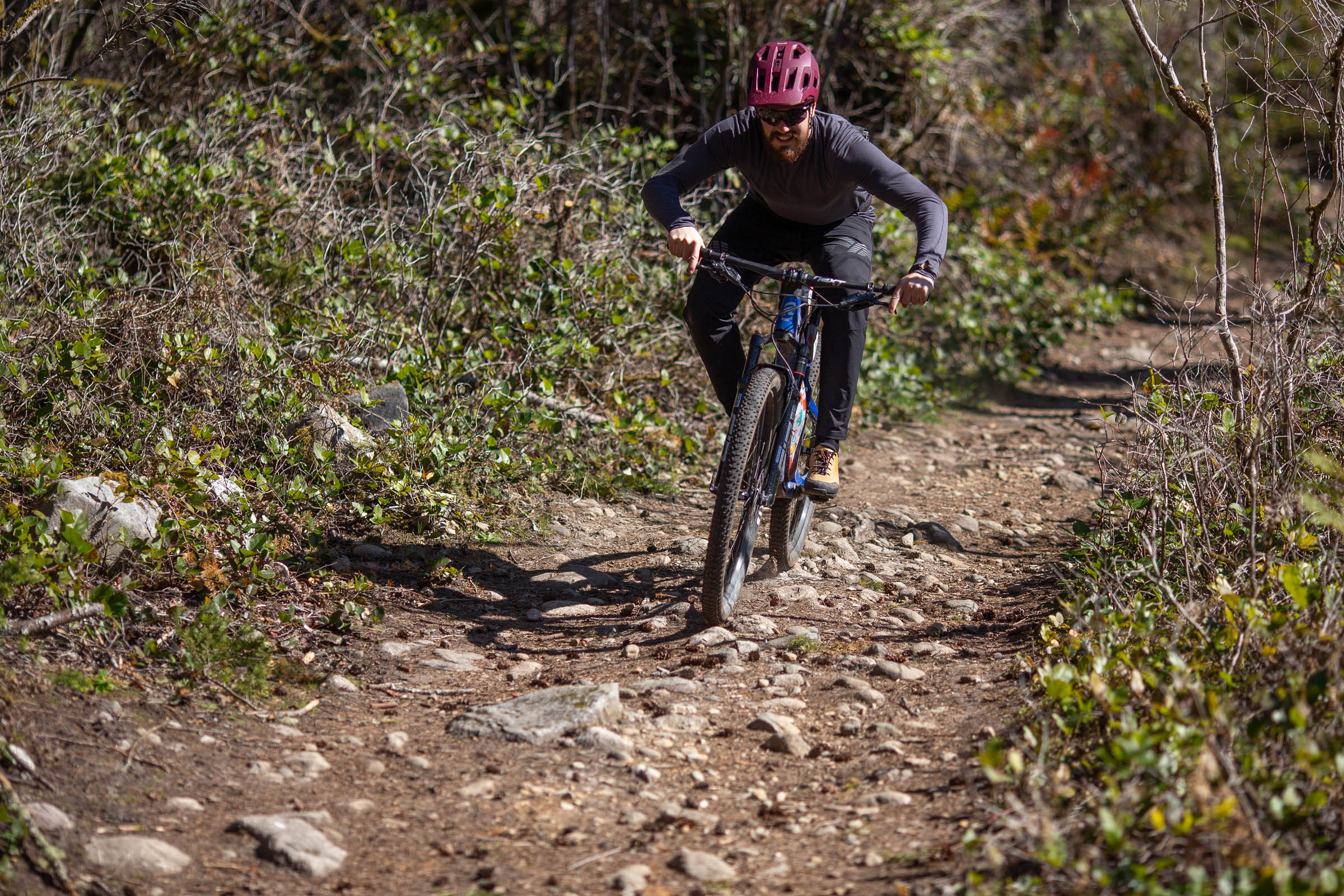
First Impressions
The first time I jumped on the Hei Hei, I’ll admit I didn’t really connect with it. I haven’t ridden a true cross-country bike in a long time, and the Hei Hei felt quite foreign to me. Although its geometry isn’t wildly different from bikes I’ve spent a lot of time on, such as the Salsa Timberjack or Why S7, its featherweight build and race-focused componentry caught me off guard. The 760mm wide bars with 10mm of rise, slim Kona Key grips, and snappier front end (owing to its shorter fork trail) were all new to me, and I felt like a fish out of water during my first few rides. I’m more used to the grip of chunky 2.8” tires, handlebars with extra rise, and a more relaxed riding position.
Although Kona designed the latest Hei Hei to be more capable than ever, it’s still a cross-country bike, so I decided to throw away my short-travel, full-suspension dreams and ride it as it was meant to be ridden. For me, that meant fast, multi-surface rides. Sure, the Hei Hei’s race-ready build was partially to blame for finding its limits on some steeper, looser trails. But it’s designed for cross-country riding first and foremost, not the other way around. There are plenty of slightly more capable short-travel mountain bikes out there if that’s what you’re looking for. The Hei Hei forgoes heavy, chunky tires for lightweight 29 x 2.25” rubber, keeps the build light yet capable, and prioritizes efficient pedaling over pretty much everything else. It felt solid and snappy when pedalling seated, and the Hei Hei’s rather minimalist suspension does a great job of soaking up most bumps, roots, and rocks along the trail. I wasn’t setting any records in the descents, but I was clearing technical climbs and rock gardens with ease and wasn’t having to stand up out of the saddle to make that happen.
It took some time to appreciate the Hei Hei’s racey demeanor, but after a lightly loaded trip down the Lower Sunshine Coast Bikepacking Route this spring, as well as too many local high-speed singletrack rides to count, I eventually got into a groove. After a while, I really started to jive with it. Did I sometimes wish for chunkier tires here in the Pacific Northwest? Sure. Did I imagine a Hei Hei with longer travel and a more trail-oriented vibe? That’s what the Kona Process 134 is for! The point is, the Hei Hei is going to have some limitations if you only focus on your preferences and strengths as a rider—but if you ride to its strengths, it just might blow your mind.
Besides riding quicker than I’m used to, I had to tweak my riding style and position on the bike to get the most of the Hei Hei. That meant embracing the slightly more aggressive riding position by keeping my chest low and over the stem, elbows bent, and for the most part, the saddle raised. The result was a powerful and responsive ride quality that glides effortlessly through nearly anything you can throw at it—right up until you need bigger tires, that is. The low top tube, 175mm dropper post (on the size large), 760mm wide bars, and lightweight build provided some of the best bike-body separation I’ve experienced, allowing me to lean the bike harder into corners and keep up speed on tight, twisty trails. The Hei Hei’s moderately steep 75° seat tube angle, 67.5° headtube angle, longer reach, and long wheelbase all add up to a snappy, responsive ride that maintains its speed in the flats and on climbs. These characteristics rang true on all but the steepest of descents, at which point the Hei Hei felt like it lacked control.
The 120mm shock and fork and semi-slick XC race tires are all quick to alert you when you’ve taken the Hei Hei too far. For most riders, I’d wager that the 2.25” Maxxis Rekon Race tires will be the first thing that gets swapped out. There’s simply not much to them, and although they were fast on everything I rode, the grip just wasn’t there when I needed it most. As for Kona’s claims for 29 x 2.5” tire clearance, I think that’s being a tad generous. There’s some lateral flex in the rear end of the bike, and although a 2.5” tire fits, it wouldn’t take much to rub on the chainstay if you’re riding hard. If you want a full-suspension mountain bike with ample space for 2.5” tires, I’d suggest looking elsewhere.

Kona Hei Hei CR/DL Build Kit
As expected for a $6,499 USD bike, the Hei Hei CR/DL’s build kit is about as nice as you can get. It’s built up around their high-end Race Light Carbon frame, RockShox Sid Luxe shock and Sid Ultimate fork, and a mix of SRAM XX1 and XO Eagle 12-speed drivetrain bits. The carbon Raceface Next 35 bar and Turbine stem are a nice touch, and the complete package leaves little room for improvement. I did have some early trouble with the RockShox Reverb dropper post, which was sluggish this winter in the cooler temperatures. I’ve used the air purge valve once already this spring, but it’s still a little squishy. Although the Reverb is on the high end of dropper posts, I think mechanically actuated posts and levers feel and function far nicer. Plus, they’re easier to service in the field.
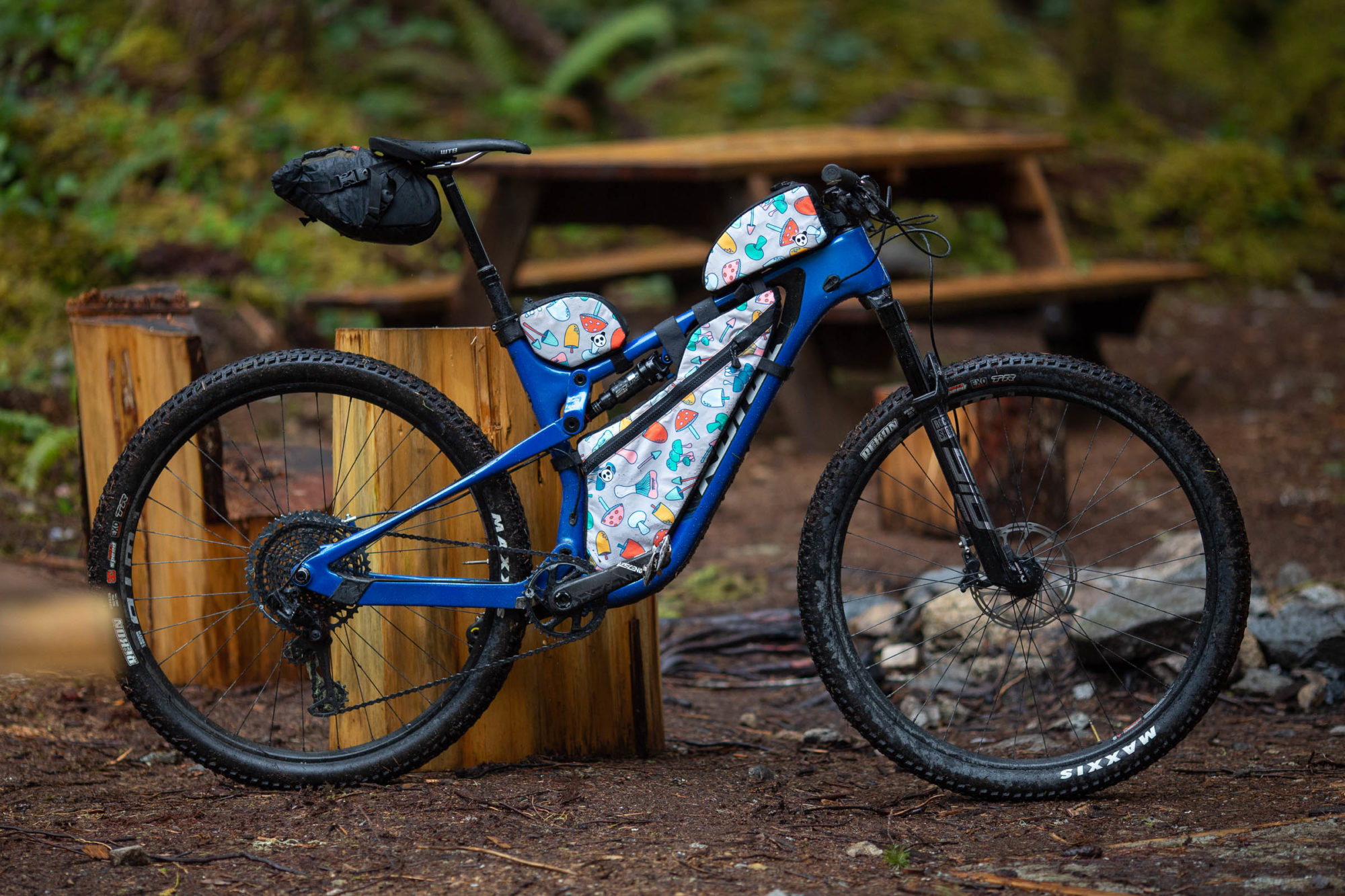
Build Kit
- Frame Kona Race Light Carbon
- Rear Shock RockShox Sid Luxe Ultimate 120mm
- Fork RockShox Sid Ultimate DebonAir 120mm
- Crankset SRAM Descendant DUB Carbon, 34T X-Sync Eagle
- Cassette SRAM XX1-Eagle 10-52t 12-speed
- Rear Derailleur SRAM XX1-Eagle
- Shifter SRAM XO-Eagle
- Chain SRAM XX1-Eagle
- Bottom Bracket SRAM DUB PF92
- Headset FSA No.57E
- Brakes SRAM G2 RSC
- Brake Rotors SRAM Centerline 160mm / 180mm
- Front Hub DT Swiss 350 110x15mm
- Rear Hub DT Swiss 350 148x12mm
- Rims WTB KOM Light i27 TCS 2.0
- Spokes Sandvik Stainless Black 2.0/1.8 Butted
- Tires Maxxis Rekon EXO TR 3C 29×2.25″
- Handlebar RaceFace Next 35
- Stem RaceFace Turbine SL 35
- Seatpost RockShox Reverb w/1x Remote Lever 31.6mm
- Saddle WTB SL8 Pro
- Grips Kona Key Grip
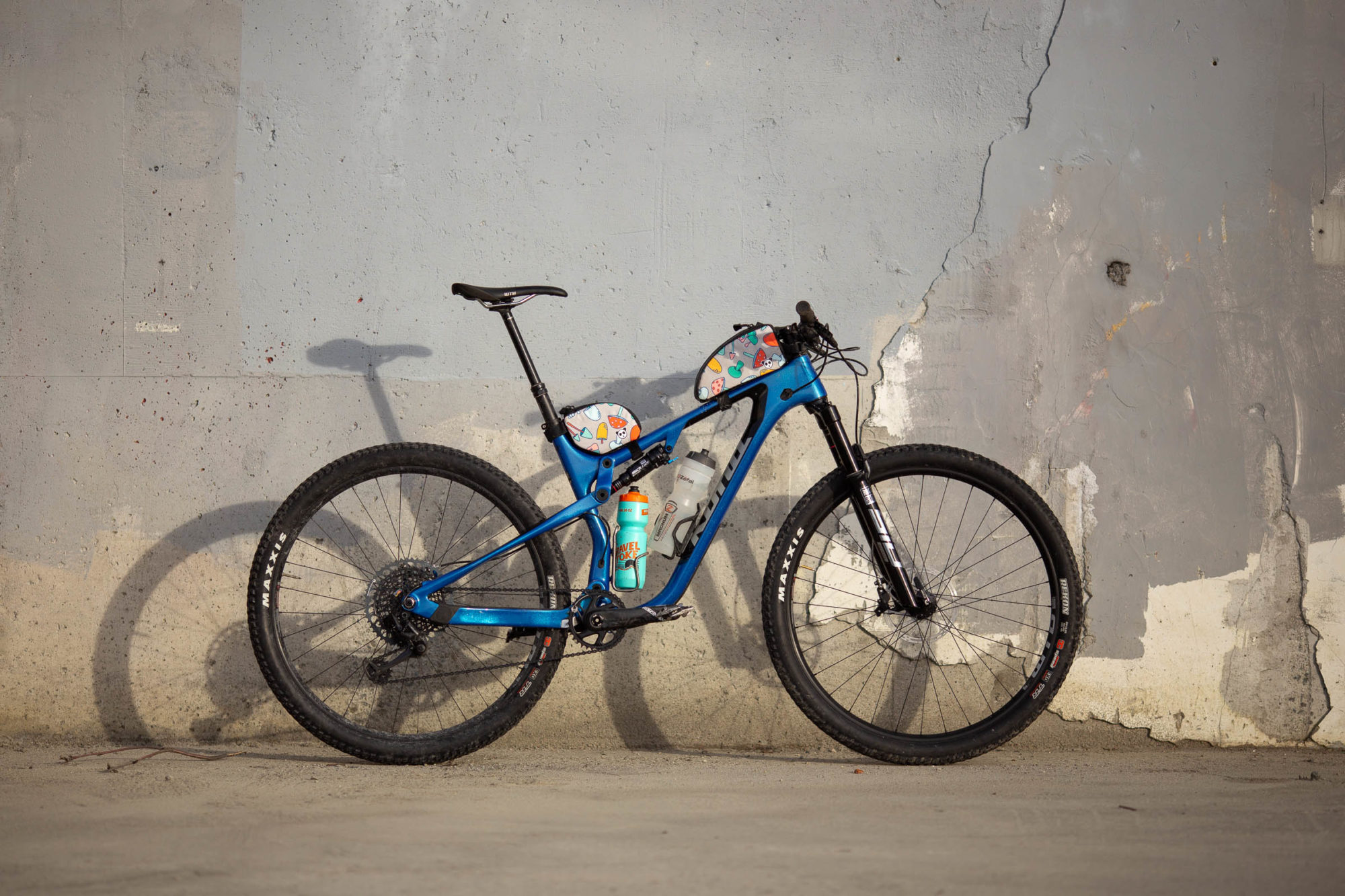
Aside from some XC components being less than ideal for a dedicated bikepacking rig, I have few complaints about the Hei Hei’s specs. If I were in the market for a Hei Hei, I’d likely give the mid-level Hei Hei CR build a good look as it uses the same Race Light Carbon frame and WTB KOM Light Team wheels but saves some cash on a Shimano SLX/XT drivetrain, Shimano brakes, and Fox Float suspension.
Bikepacking on the Hei Hei
Once I began to discover the Hei Hei’s strengths, I grew excited about the prospect of using it as a lightly loaded bikepacking speed machine. Rogue Panda Designs kitted out the Hei Hei I tested with a custom-printed frame bag and top tube bags, which remained on the bike for most of the time I had it. On the size large, I could easily fit a 2L water bladder, my Vargo BOT 700 (with stove stashed inside), water filter, pump, repair kit, two dehydrated meals, and lots of snacks. What’s the argument for bikepacking on a hardtail, again?

Being such a light bike, I was curious to see how the extra weight of a bikepacking kit would affect how it felt on the trail. Thankfully, I was able to get out on several local bikepacking trips throughout the spring, which gave me a good grasp on how the Hei Hei performs as a bikepacking rig. On paper, you’d think the Hei Hei’s short-travel suspension and lightweight design are the first signs that it isn’t suited to the extra weight of a bikepacking kit. As mentioned earlier, the Hei Hei felt out of place on steep, technical trails where some more traction was needed, and I think the added weight of my loaded bikepacking bags toned down its racy vibe. The extra weight of a couple of feed bags and a handlebar roll improved stability and slowed down the front end of the bike, reducing my desire to hammer down every trail. Overall, it felt quite natural with a few bags on it, and I could see the Hei Hei as an ideal self-supported race rig where singletrack is abundant and speed is crucial.
As expected, not all components specced for cross-country racing are conducive to bikepacking. I couldn’t stand the paper-thin Kona Key Grips and immediately swapped them out for some Ergon GA3s, which was essential for my comfort on longer trips. The RaceFace Next 35 bar is responsive and comfortable for fast-paced rides, but the 10mm rise, 760mm width, and 8° sweep were a touch too aggressive for laid-back bikepacking. Being a narrower bar than I’m used to, paired with SRAM brake levers, I found it a little tricky to make room for my handlebar roll and eventually had to tilt my controls upwards to avoid pinching my brake lines excessively—the primary reason why I prefer Shimano brakes. To be nitpicky, it would be nice to see some bottle mounts on the underside of the downtube for an extra bottle or cargo cage.
Hei Hei as a Trail Bike
Although Kona’s build kits cater towards the XC crowd, the Hei Hei has all the fixings of a capable trail bike, if that’s the direction you want to take it. It could be as simple as swapping out the tires and handlebar for a 2.4” Rekon / DHF combo and wider riser bar, a relatively small change that would provide additional grip and stability on steep, chunky trails. The frame itself takes some design cues from its more downhill-oriented sibling, the Process, with large pivot points and bearings, beefy chainstays, and rubber chainstay guards.
I never felt that the Hei Hei’s suspension was a limiting factor in more challenging conditions, especially since the updated design makes the most out of its short travel. Kona’s Fused Independent Suspension is unique to the Hei Hei. While most full suspension mountain bikes have a pivot point at the seat and chainstay junction, the Hei Hei relies on a small amount of flex in the seat stays instead. While this reduces weight and maintenance, I believe it’s also to thank for a lot of the bike’s responsiveness. The rear end of the bike feels firm when pedaling on easy terrain, including smooth singletrack, doubletrack, and gravel roads, but the 120mm of rear travel and fused suspension were immediately noticeable when riding on rougher trails. The further you push the rear shock, the more the seat stays flex, which ramps up quickly during bigger hits and drops. This was most noticeable during fast, chunky descents. On bigger hits, a trail bike with a multi-link rear end will undoubtedly feel plusher, but I doubt you’d experience the same snappy climbing ability the Hei Hei offers.
The Hei Hei floated its way up, over, and down most obstacles I put in its path over the past four months. It proved to be much more confidence-inspiring than I initially believed it would be, and although it took some time to get used to, I can report that I don’t think Kona has exaggerated its claims about the Hei Hei’s capability.
Who’s it for?
My experience riding the Hei Hei changed dramatically as the conditions here in the PNW improved over the last couple of months. In the middle of winter, among slippery roots and rocks, the Hei Hei’s cross-country demeanor was all too apparent and had me wishing for bigger tires and a more stable cockpit. Now that the trails have dried out, I’ve had the opportunity to push it further towards Kona’s self-proclaimed “fun-country” category and away from its cross-country roots.
The Hei Hei is a fantastic platform, and although its speedy 2.25” tires and low-rise handlebar had me making some assumptions early on, it ended up being much more capable on trails than I had imagined. As I mentioned, a quick tire swap and a new handlebar would help create a more stable platform for bikepacking and general trail riding—shifting even closer to the “down-country” category touted by some brands.
So, who is the Hei Hei for? I think it could make a great fit for anyone who enjoys short to mid-travel mountain bikes but primarily rides terrain that makes it challenging to decide between a full-suspension trail bike or a hardtail. With the Hei Hei, you get the benefits of having a rear shock and dialled suspension without the weight and complexity of a more downhill-oriented trail bike.
However, it’s an expensive bike, with the base-level aluminum build already coming in at $2,799 USD, the Hei Hei CR at $4,599, and the CR/DL build I tested costing $6,499. So, unless you’ve got a serious need for speed or are committed to the hybrid cross-country/trail bike category, I’d likely direct you towards the Process 134 or one of the other short-travel trail bikes on the market.
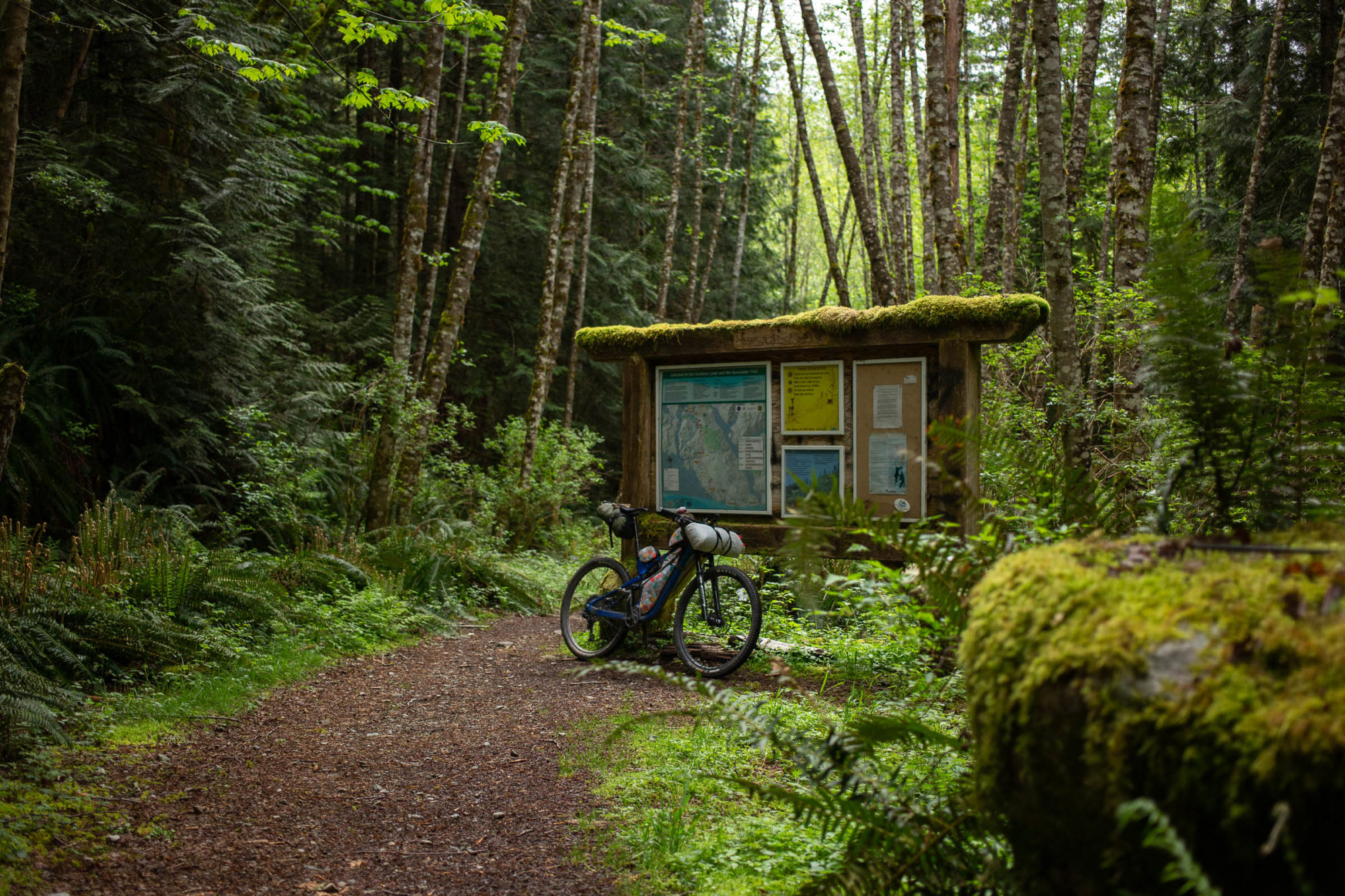
Pros
- Impressive pedaling efficiency and suspension characteristics while in the saddle
- Lightweight, high-performance build is thoughtfully designed and suits the bike
- Lots of space in main triangle on carbon builds for a custom frame bag or two full-sized water bottles
- Progressive cross-country geometry can handle a lot more than other short-travel XC bikes
Cons
- CR/DL build is pricey
- 2.5” tire clearance is pushing it
- 2.25” Rekons are limiting
- Not a diehard race bike or a true trail rig, which might not suit your needs
- Model Tested: Kona Hei Hei CR/DL
- Weight (as tested): 25.8 pounds (11.7kg)
- Price: $6,499 USD
- Place of Manufacture: Taiwan
- Manufacturer’s Details: KonaWorld.com
Wrap Up
The Hei Hei is a super-capable cross-country speed machine that rarely feels out of place. It’s responsive, lightweight, and fast as hell. It’s the type of bike I’d want to show up to a bikepacking race with and would make a perfect rig for events where a hardtail is suitable, but full-suspension would be nice, and you want to keep your setup as light as possible. Effortlessly linking gravel roads and singletrack together was refreshing, and having space for a big frame bag was a bonus for long days on the bike.
Once I got used to it, it was hard to not ride the Hei Hei like a full-blown trail bike, especially because it can handle nearly anything reasonable you decide to throw at it. The parts spec and overall design scream cross-country race machine, but certain aspects of the bike, including its progressive (for an XC bike) geometry and tire clearance, push it into a category of its own—what Kona describes as “fun-country.” If I were to keep riding the Hei Hei this summer, I’d toss some chunkier 2.3” tires on it and a wider bar with some rise, and I’d gladly spend hours climbing in search of backcountry descents.
Related Content
Make sure to dig into these related articles for more info...
FILED IN (CATEGORIES & TAGS)
Bikepacking Bikes
Full-suspension
full-supension-bikepacking kona-bikesPlease keep the conversation civil, constructive, and inclusive, or your comment will be removed.







